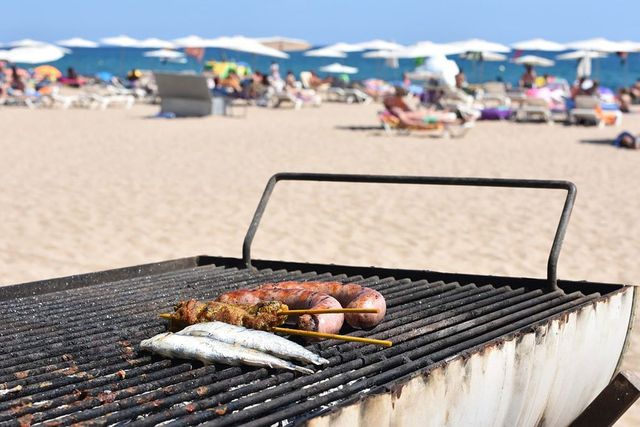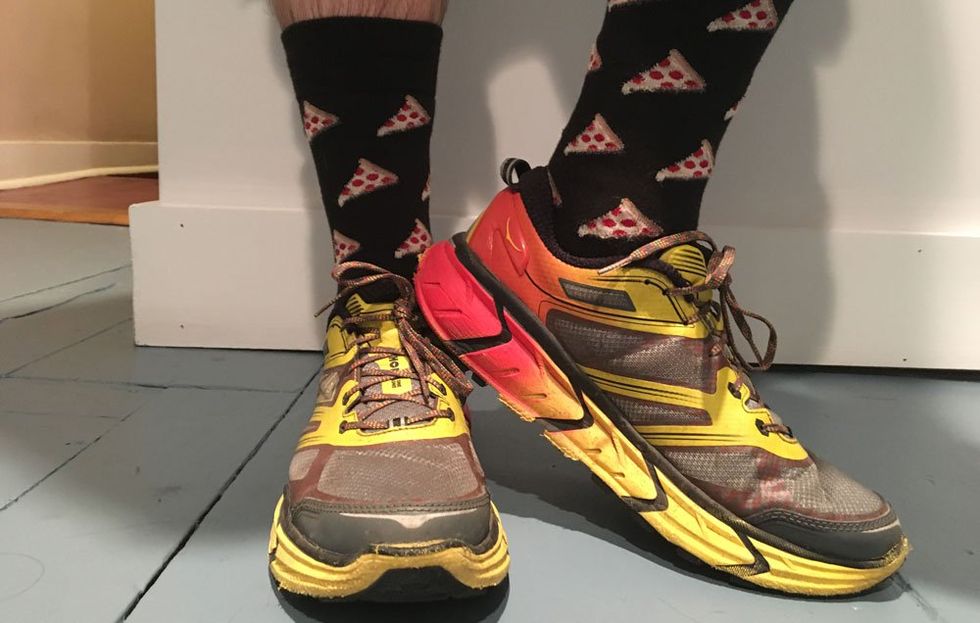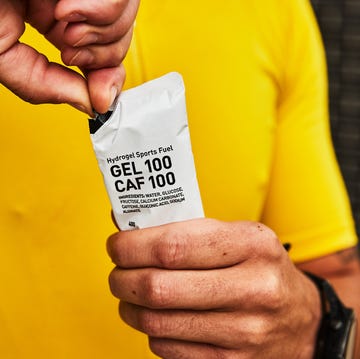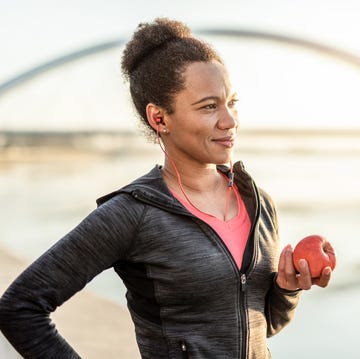When we last checked in with Caleb Daniloff, two weeks into his vegetarian diet, he was grappling with some transition issues: a perceived meat withdrawal, along with a few disappointing race results. We pick up with Caleb as he navigates his first beef-/chicken-/bacon-/sausage-free vacation.
Day 21
It’s 11:43 a.m., the sun is shining, and I’m pinned to the couch, one sand-speckled arm draped over the side, head tilted, eyes closed. Like Marat in the bathtub. I feel nauseous, wiped out, dim-witted. That peanut-butter-honey sandwich was definitely not the answer to this morning’s steamy eight-miler. Maybe the sun got the better of me at the beach afterward. Or did my neural pathways short-circuit at the change in routine? For years, tides and salty breezes signaled leftover fried chicken and cold burgers—not veggie wheat wraps and fruit cups. My wife brings me some cheese and crackers, and I perk up a little. I make some oatmeal. But 90 minutes later, I’m back on the couch, my belly growling like it’s national Talk Like A Pirate Day. This is definitely going to jam up the mindless rhythm of vacation. When I was a platinum-card-holding member of Carnivore Nation, I could count on a solid four-to-five hours of non food-worry—to live my life and, you know, do stuff. Now, I’m thinking about food constantly: what, when, how much, and what will they have for me on the menu?
Staring at the ceiling, I hear the voice of my vegan-nutritionist friend Micah: “Eat more. The number one reason people stop eating vegan is because they don’t eat enough calories, which leaves them feeling unsatisfied, unsated, and even weak. The thing is, plant-based foods are usually more nutrient-dense but not more calorie-dense than food sourced from animals. I can’t say it enough—eat more calories!” (Nutrient-dense, meaning more nutritious bang for your caloric buck.)
7:01 p.m.
For dinner, I heed the calorie call with a cheesy flatbread, a sweet potato with pecan-marshmallow brulee (yum!), and a stop at Backdoor Donuts. I hope this is what Micah had in mind. I’m just about to rip into a fat, still-warm maple-bacon donut when Chris puts her hand in front of my salivating lips. I’m stunned at how robotic I am, even after three weeks. I pick off all the bacon shards and stack them in a sad little pile. I can feel the pitying eyes all over me.
Day 24
My eight-mile run this morning is slow. My speed collapses within fifteen minutes. All my runs have been like this lately, a good minute-per-mile off pace. I’m trying to be okay with it, but I feel foolish having registered for a 50-miler. Did the audacity of my diet overhaul bleed into my race ambitions? I remind myself to have faith. That endurance giants Scott Jurek, Charlie Engle, and Rich Roll are plant-based runners. That gorillas don’t eat meat.
Note to self: re-read Jurek’s book Eat and Run but don’t skip over all the recipes this time.
Day 25
For lunch, I try a grilled black-bean burger with quinoa tortilla chips, along with a spinach and avocado salad. Watermelon for dessert. The burger isn’t bad, though I miss the juiciness, and, well, the burger. I’ve introduced edamame and almonds (for protein) into the rotation, as well as with beets (anti-oxidants and anti-inflammatories). Beets taste like earthworms pickled in dirt.
I’m waiting for the day this becomes a reality on the menus around here.
Day 27
I leave my Garmin behind. It’s become a depressive, a nasty little digital face sticking its tongue out. Every time I check the display (which is far too often), it reads, “You are one slow-ass knuckle dragger: why don’t you have another donut?” But this morning’s six-miler along the bike path and through the woods is surprisingly strong. My hip is a little tweaky, but I feel solid, potent even, that I have the required effort to move my body without feeling like I’m stumbling out of a crime scene with a safe on my back. Not only that, but the miles are strong all the way through, even after I’ve sweat out the coffee. Is this the one? Almost a month later. The turnaround run?
Month One takeaways:
1) Have patience. There was comfort in mindless eating, so expect a little discomfort at first. Vegans talk about an awkward two-week period before things start clicking and strength and speed start to increase. For vegetarians, I’d multiply that by two or three.
2) Being a vegetarian is more than being a non-meat eater. Eat a lot more fruit and vegetables every day. Be open to meat substitutes. Your palate will definitely need to be retrained. But as a former drunk, I’m convinced you can get used to, and unused to, anything.
3) Get on the supplement train as you adjust for the nutrients that once came from meat. In addition to multi-vitamins, I’m taking vitamins D and B-12, iron, Omega 3, calcium, and a protein powder. Consult with a doctor or registered dietitian. Ultimately, the goal will be to figure out how to get what you need from veggies alone.
Day 31
Strong run to Harvard Stadium for a November Project workout. But skip two weeks and the coliseum makes you pay. The concrete steps are obscenely tall (because they’re actually the seating rows). Returning from vacation always sends me back to the farm leagues, and I mount the stairs this morning ready to submit. Might as well be wearing a studded choker. But to my surprise, I’m able to run almost the entire 40 minutes, clocking about a minute a section, only a little slower than normal. And I hoof it home on nine-minute-mile legs, not the usual post-stadium zombie shuffle. Even my shadow looks faster. I feel cautiously incredible. Emboldened, I try tofu hot dogs for lunch. Not bad.
I’ve also discovered Upton’s Natural seitan chorizo bacon and sausage. It’s fairly-to-pretty close in taste and texture. Their site has plenty of meat-substitute recipes.
Day 33
Is it still okay to wear my pepperoni-pizza socks?
Day 35
A runner friend asks me how I get my protein now. I see the concern in his eyes. “Eggs, tofu, yogurt, spinach, almonds, beans,” I answer, even surprising myself with my list. He doesn’t seem convinced. “Oh, and Muscle Milk*,” I add. That seems to put him at ease.
*Several nutritionists and dietitians I’ve spoken with warned me about the cholesterol and added sugars in popular protein powders like Muscle Milk. More than one suggested the plant-based Vega.
But how much protein do we actually need? One online calculator spat out 165 grams per day for my weight and activity level. Other sources dropped it to the mid-50s. I ask my friend Tara Mardigan, author of Real Fit Kitchen and former nutritionist with the Boston Red Sox.
"Athletes tend to think they need tons of protein, often from meat,” she says. “They think 'More is better. More equals bigger muscle.' Truth is, athletes need more of each nutrient to fuel and repair properly. Too much protein can easily crowd out the other nutrients.”
Tara says, as an active athlete, I need .5-to-.6 grams of protein per pound of body-weight a day and up to .8 grams if my training and mileage become more intense (which it has). So at 165 pounds, that’s between 86 and 132 grams a day. Okay, I’m under-protein-ing. Time to rejigger. Rejiggering seems to be big part of this process.
Note to self: keep this list of non-meat proteins handy.
Day 40
Pizza binge! Shit. I’m pinned to the couch, a cheesy dough baby in my belly, lips glistening, fingertips lacquered in grease. Because of poor planning and after-work obligations, I wasn’t able to eat for hours. I quickly grew ravenous. Then angry, distracted, short-tempered. As soon as I got free, I destroyed an entire large cheese pie in minutes, a blur of hands and teeth. It was a total relapse, just without the meat.
Note to self: get much better about snacking throughout the day; almonds and walnuts are good. Inner Peas from Trader Joes also work well.
Day 43
Got my blood results from Inside Tracker, a health analytics company geared toward athletes. Of the 20 biomarkers I was tested for, eight came back as “needs work.” Not surprisingly, my cholesterol and glucose were elevated. My iron was low, as was my hemoglobin, which helps move oxygen. So was my magnesium, which plays into healthy blood pressure, muscle fatigue, and cognition. Inside Tracker offers up related articles and research studies, along with dietary suggestions and nutritional advice to address deficiencies. In my case:
Iron: Spinach, dark chocolate, peanut butter
Glucose: Fiber cereal, avocado, rolled oats, raspberries
Cholesterol: Artichoke hearts, blackberries, russet potatoes, avocados
Magnesium: Quinoa, pumpkin seeds, Muesli cereal, spinach
Inflammation: Pecans, almonds, almond butter, pistachios
Day 48
“Do vegetarians poop more than meat eaters?” Staring at the stall door again, I find myself typing these words into a search window. The answer from most corners is yes. More fruit and vegetables mean more fiber, which means more passage. And if you’re following instructions and eating more calories, well, that’s more food that needs an exit strategy. But it also spells less constipation and diarrhea. Meat tends to sit in the colon longer (several days) because it’s harder to digest and may play a role in increasing the risk for colon cancer. So more poo, less cancer.
Day 51
Didn’t get to bed until after midnight. Wasn’t planning to run, but my internal clock is a honey badger and wakes me at 4:50 a.m. By the time I step out the door, it’s a steamy 75 degrees, the latest episode in a Boston heat wave. This kind of heat usually slaps a kick-me sign on my pace. But not today. I was dictating the run, not the other way around. To prove I still had juice at the end, I even cranked up my last half mile to a minute-per faster than normal. I think this makes for seven solid runs. I can’t say there’s been miracle improvement, but there is a new consistency and a disruption of running patterns. And I find myself excited about the next run. I know I’m probably still in the honeymoon phase, but I’m just about ready to believe.
Month Two Takeaways
1) Resist Protein-Deficiency Anxiety. The marketing of protein is at a ridiculously high pitch, according to this article. And it’s not the only thing you need to be thinking about, says nutritionist Tara Mardigan.
“Athletes often need more carbs, more fat, too. They always need more micronutrients and phytonutrients from plant-based foods to help quiet inflammation. That's the part that's often missing from an athlete's eating pattern. Balance of nutrients, high-quality real foods, much more color and consistency. Paint your plate. It works!"
2) Allow the mindfulness a new diet requires to spill into other areas of your life; for example, be more conscious of how you run—your gait and arm swing, your breathing, your habits, your routines. In other words, think about the things you normally don’t think about. I’m also hoping all this extra thinking will jolt my brain into remembering why I walked into the kitchen this morning holding a pair of scissors and my old eyeglasses.
Check back next time as Caleb runs the perimeter of Manhattan in preparation for his 50-miler and gets the alarming results of his second blood test. Has he been doing this all wrong, he wonders.
Caleb Daniloff is a Boston-area writer and author of Running Ransom Road: Confronting The Past One Marathon at a Time (Houghton Mifflin Harcourt, 2012) and co-author of November Project: The Book: Inside the Free Grassroots Fitness Movement That’s Taking Over The World (Rodale, 2016).
Caleb Daniloff is a Boston-area writer and author of Running Ransom Road: Confronting The Past One Marathon at a Time and co-author of November Project: The Book: Inside the Free Grassroots Fitness Movement That’s Taking Over The World.















